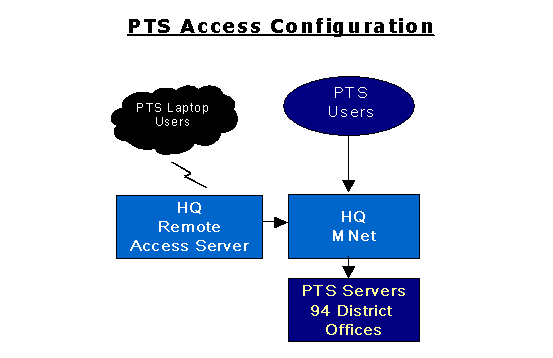The United States Marshals Service (USMS) is responsible for housing federal prisoners awaiting trial in federal courts. On any given day, the USMS maintains custody of approximately 40,000 federal prisoners in local jails, contract facilities, and federal Bureau of Prisons (BOP) facilities throughout the country. Depending upon the length of a prisoner's court trial, time spent in USMS custody may run from several days to several years.
The USMS Prisoner Tracking System (PTS) supports the USMS's responsibility to maintain custody of individual federal prisoners while criminal proceedings are pending. This period of custody extends from the time of their arrest or remand to the USMS by the court until the prisoner is sentenced, released from custody, or returned to the custody of the U.S. Parole Commission or the BOP.
The PTS was implemented by the USMS in March 1993 to maintain tracking information for federal prisoners and to monitor federal prisoners in state and local detention facilities under contract to the USMS. The PTS replaced the Prisoner Population Management System. The PTS captures information necessary to complete the administrative processing, housing, safekeeping, health care, and disposition of federal prisoners in USMS custody.6 From fiscal year (FY) 2001 to FY 2004, the PTS's total operating costs were $3,370,000, with annual operating costs averaging $842,500. Another $1,070,000 is projected for FY 2005 and a project to upgrade the PTS application's functionality, funded at $5 million over a 5-year period, is currently underway.7
The PTS is also used as an informational and scheduling tool. As an informational tool, the PTS provides identifying data specific to each prisoner, including the prisoner's personal data, property, medical information, criminal information, location, and time spent at a facility. As a scheduling tool, PTS information assists USMS personnel in locating prisoners to be transported for court appearances.
In addition, the PTS also contains records of court proceedings generated during the day-to-day processing and disposition of prisoners in the USMS's custody. Prisoners' records contained within the PTS are created using information obtained from key source documents, such as the individual custody and detention form, intake photos, Federal Bureau of Investigation (FBI) finger print cards, and the prisoners' medical form.
PTS Application System Environment
The PTS application software runs on a local server in each of the 94 USMS district offices (DOs) located throughout the U.S. and its territories. In addition to the application, a database is maintained on the local server that contains information relative to prisoners processed by the DO. Thus, the USMS PTS environment consists of 94 copies of the PTS application along with 94 individual databases.
At each DO, PTS client workstations connect to their local PTS application server to gain access to database information. PTS users initially log into the Marshals' Network (MNET) located at the USMS headquarters in Arlington, Virginia, in order to log into the PTS application server at their location. Additionally, remote users can gain access to the PTS server in their district by dialing into the remote access server located at the USMS headquarters. The user is required to provide additional remote access user identification information in order to log into MNET. The following diagram depicts the PTS's access configuration.

Footnotes
- USMS System Security Plan for the Prisoner Tracking System (PTS)/USMS Automated Booking System (USMS-ABS), June 2003.
- Operating costs were obtained from budget requests submitted to the Office of Management and Budget by the Justice Management Division.